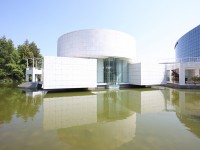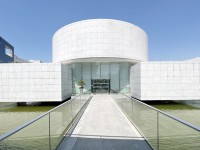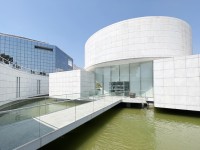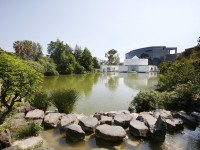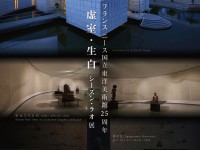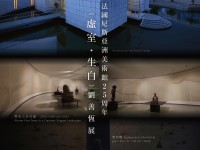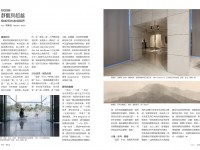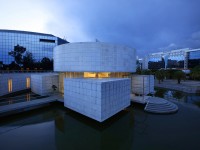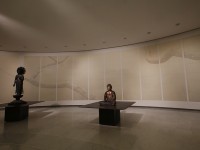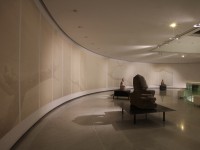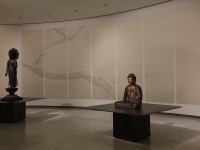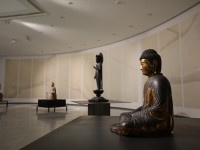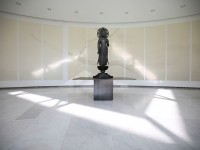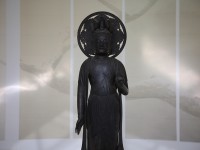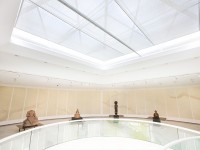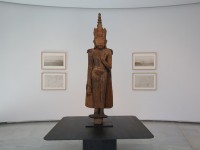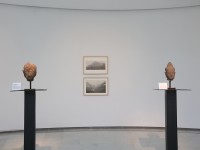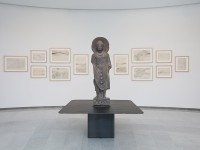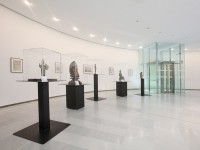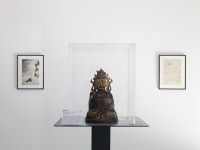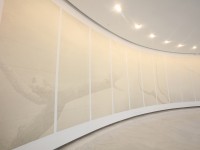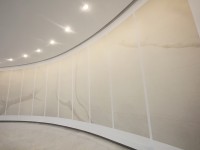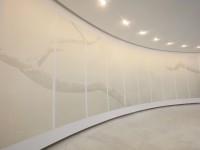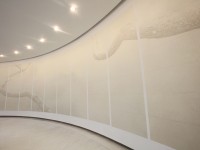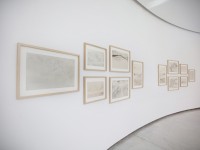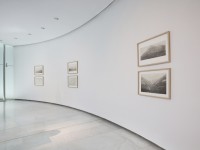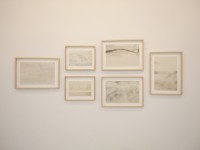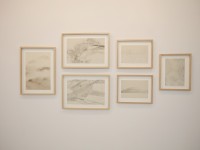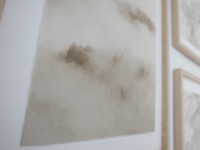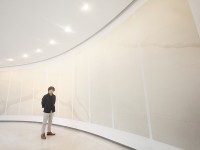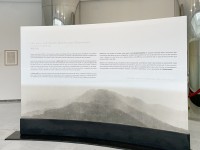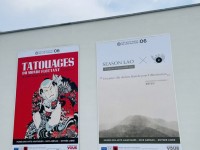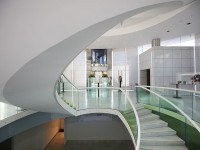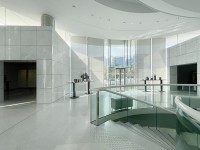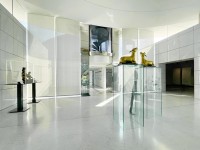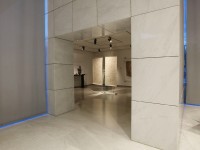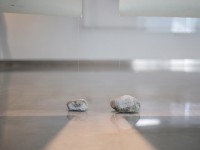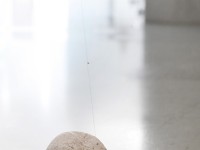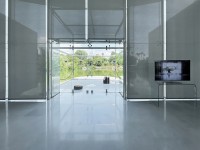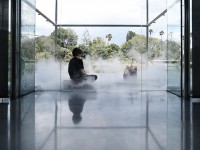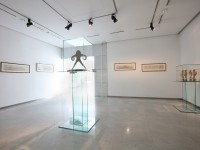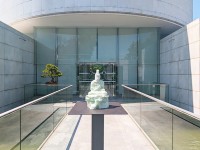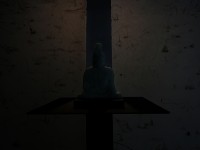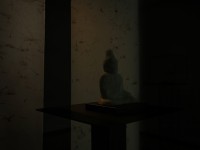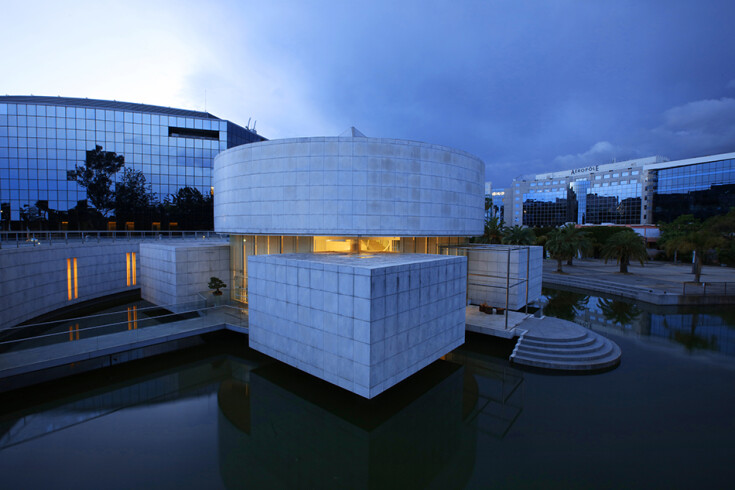
《虛室・生白 KYOSHITSU SHOHAKU》2023 May – Solo Exhibition – Musée départemental des arts asiatiques à Nice, France
Exhibition
Date : 2023.5.13-11.25
City : Nice, France
Venue : Musée départemental des arts asiatiques à Nice (Museum of Asian Arts of Nice / ニース国立東洋美術館)
405 Prom. des Anglais, 06200 Nice, France
《 虛室・生白 KYOSHITSU SHOHAKU 》 – Une pièce vide devient blanche pour l’illumination Exposition 劉善恆 Season Lao
《 虛室・生白 KYOSHITSU SHOHAKU 》 – An Empty Room Turns White For Enlightenment 劉善恆 Season Lao Exhibition
- 日本語
- Français
- 中文
- Englsih
静観と超越ーシーズン・ラオの造境視界
The Tranquil Gaze and Transcendence: Season Lao’s Visual World of Creative Dimension
廖新田 国立台湾芸術大学芸術管理文化政策研究所教授 元国立歴史博物館(台湾))館長、オーストラリア国立大学名誉教授萬物靜觀皆自得,四時佳興與人同。
道通天地有形外,思入風雲變態中。-宋 程顥《秋日偶成》
虚実相生
シーズン・ラオ(劉善恆)の丹下健三の建築空間における展示は、そのこと自体は虚と実との間、興味深い対話である。この独特な美術館の基礎造型は、無地材質を賢明に組み合わせた構成で、純粋で厳粛であり、「宗教的な」神聖さとカタルシスを感じさせる。芸術家シーズン・ラオの今回の展覧会のテーマは「虚室・生白」である。「虚室」は丹下健三の空間建築のコンセプトと共鳴し、その精神には「汎東洋」の自然哲学が含まれていることがわかる。「実」は「虚」の表層であり、「虚」は「実」の核である。外を以って内を為し、内と外は相通ずる。互いに表と裏の関係にあり、相生相克である。「虚的な思考」の意味合いで考えることが必要である。「虚空」は「虚無」ではなく、前者は積極的に身体に受容され行動を誘発するものであり、後者は消極的に退縮するものである。
「虚室」は、中国語の「虚実」の発音に非常に似ており、読むときに換喩的な二重の意味を連想させる。「虚室」は、この空間で人の体と思考を新たな行動に導く。空になったら埋め、満ちたら取り除く...生生流転。 芸術家が創造した「虚室」の中、人々は自分自身を見つめ直し、身も心も整える。 観自在、自由自在に見る。 ささやかな波が立ち、澄んできらめく水の上にゆっくりと浮かび上がる美術館、「虚室・生白」のインスタレーション作品の中で水気と雲霧,柔らかさと硬さを象徴する特質が絡み合い、陰と陽を現すとも見えるかもしれない。老子の『道教経』には、「善は水の若し。水は万物を善く利して、而も争わず。衆人の悪む所に居る。故に道に幾し。(上善若水。水利萬物而不爭,處眾人之所惡,故幾於道。)」という言葉がある。老荘は硬直を克服するために柔らかさを提唱した。虚の空間は水と優しさのようで、自由を妨げることなく万物と最も密接に適合し、真、善、美の最高の領域の比喩である。偶然にもラオ氏の漢字名にも水と関係の深い「善」が入っている。
計白当黑、無為自然
「虚室・生白」の第二テーマである「生白」は、ニース東洋美術館の真っ白な外観と呼応する他に、「汎東洋」の伝統芸術のイデアを示唆している。書道にもよく見られる、黒い線が交錯することで形成される不可視の白の空間が肝要な部分である。例えば、水墨画の「余白」は気韻生動のフィールドである。生命の節奏と美学の韻律の創造である。山水画において、余白は雲や流れる水を暗示しており、その「残す」という考え方は「気韻生動」を醸造する。「無」は「有」の源である。「黒を記す(當黑)」ことは簡単だが、(生白)白を生じるのは難しいーー前者は占有する、強勢的な作為であり、後者は揖讓し、環境全体を見て関係を思慮する。「計白當黑」は「前進するためにはまず後退する(以退為進)」という対策と態度であり、シーズン・ラオは作品の中でこういった境地を流用(appropriation)して昇華(sublimation)している。彼の「余白」と「気韻生動」は芸術家の主体に完全に支配されるものではなく、自然の縁起から生じる。画面上の天地は、どこかに実際に存在した「虚」と「実」の精神の交錯する瞬間である。その手法は「無為自然」という哲学観と内面的に共鳴するものである。
余白は美的快楽(hedonism)の源の一つであり、カントの没利害性(disinterestedness)が発生すると、人間の脳は生存や認知のために働かなくてもよくなり、リラックスした状態が生まれる。たとえば、残蓮の景色に直面すると、目の前にある美しさが、利害を超えたいという欲求を生み、身体感覚を想像力に支配させる。シーズン・ラオは芸術経験が叙述的なプロセスで完成されるとは考えていない。芸術は瞬間の知覚体験である。アメリカの批評家ソンタグは、芸術の直接的な感覚は言葉で完全に置き換えることはできないと「反解釈」(against interpretation) を用いて指摘した。ちょうどドイツの哲学者ハイデガーの「現存在」(Dasein)現象のように、今ここにおける個人の存在認識である。この時、制作者にとっての最大の課題は、繊細で無色の白を低色調の中で連なり、通り抜ける要素として、作品画面、展示空間と介入する観客を瞑想の有機的全体に融合させることである。そして悟りの可能性を指し示す。英語のタイトルはこの層の意味を暗示している: An Empty Room Turns White for Enlightenment。ここでの悟りは、外部の刺激に依存するものではなく、禅のひらめき(epiphany)のように、内なる自発的な力からもたらされる。
純粋的な優雅
世界は非常に大きいので多くの不思議があり、宇宙は非常に広大ですべてが含まれている。 複雑である必要はなく、簡静に立ち返ることで、この奇妙で広大な宇宙を理解することができる。肝心なのは心の在り方である。東洋、西洋哲学にもそのような主張がある。ひと欠片の石、一片の雲、一本の折枝は、太古の原野や空に私たちを導く。必要なのは媒介と想像である。これは静を以て動を制す美学的態度で、変化し続ける環境への対応である。イギリスの詩人で画家のウィリアム・ブレイク(William Blake)は、「一粒の砂で世界を見て、野生の花で天国を見て、手の中に無限があります。儚さは永遠です。」と言っている。 詩のタイトル「無垢の予兆」(Auguries of Innocence)は、「純粋的な優雅」(the elegance of simplicity)の概念に呼応する。両者は理論上、親和性(affinity)があり、純粋的なエネルギーを強調している。 かつて中国の唐の隠者であった龐蘊も似たような感情を抱いていた:「一つの考えは純粋であり、蓮の花はいたるところに咲く。一つの花、一つの世界、一つの葉、一つの如来。」言い換えれば、伝説の「桃源郷」 は遠くではなく、近くにある。頭を下げて見下ろすかまたは見上げるだけであるが、実はそれは「心」の変化なのである。
前述の静謐優美な美学の世界に入るため、私たちには「注目」と「関心」が必要である。-目で周囲を見て回る、魂を通して敏感に体験する。これはある種宗教的な祭典のようなもので、心と体の状態を緩慢にさせ、物我一如に至り、集中することができる。シーズン・ラオの芸術作品は、まず私に「美学の先導者」の役割を特に感じさせ、鑑賞者を瞑想の視覚的世界に導く。純粋さと静けさに近い精神的な領域、そして東洋美学の現代視野である。鑑賞と思惟がありながら身も心も整え、超越性 (transcendence) がいつの間にか現れる。
彼は造景と造境が得意で、「超越的な心境」を引き起こすためにー心と体は純粋的な優雅の中で静かに自分自身を観察し、美感を醸し出し遨遊することができる。「純粋的な優雅」は容易ではない。何故なら、少ないほど多く、一部がすべてだからである。老荘思想によれば、虚と白は万物の根源であり、「道生一、一生二、二生三、三生万物」彼の視覚装置は有機的で透過し、古代東洋との共通要素を見出す - 自然中の煙雲、絡み合った稜線、低階調の灰色調、鑑賞者が特定の空間で観視を始めるように誘導する仕組みである。 美学の探求は、鑑賞者自身にとって必須のプロセスである。シーズン・ラオの創作はこのような在処的な内省を徐々に善導する。 「間主観性」(intersubjectivity) の潜力を醸成し、体と心、精神と自然を緩め、置き換えることができる。
この観点から、丹下健三のニース国立東洋美術館と、この空間で展示されているシーズ ン・ラオの「虚室・生白」は、調和、共嗚し、どちらも「純粋的な優雅」の特質を持ち、何度もじっくりと味わう価値がある。
天地、形外、態変
「虚室・生白」では思考と観視を重視する。身体は美的な状態の体現である。実体は超越性がない。暗黒は占有することしかできない。虚空は無限をもたらし、白は生気を生み出す。これは著者が冒頭に「秋日偶成」を引用した理由でもあり、自然環境は人の感懷によって起伏し、外在世界は人の「心」に決定される;しかし人は宇宙の在り方を理解するには、「廻り道」しなければならない。宇宙は目に見える形を超えたところでしか理解できない。変化に直面しないと超越的な契機はない。物質的な欲望を捨てなければ本当の自分を明らかにすることはできない。華人文化的背景を持ち、日本の自然観と縁あるシーズン・ラオは、物我両忘という自然哲学を深く理解し、表現を行っている。
シーズン・ラオの「虚室・生白」は「指差す月は月ではない」のようなものである。この展示の目的は物質的な展示ではなく、美感空間の啓発と発酵である。月を正しく指し示す指自体が本質の月ではなく、媒介であることと同じように、指は最終目的ではなく、方角に合わせて空高く浮かぶ明るい月を眺めることによって、この想像的な旅は完結する。シーズン・ラオは、アートは素材や技術の優位性を強調するものではなく、言い換えると「トランスマテリアル」な方法で作品の物理的な境界を越える芸術経験の追求であると考えている。虚、白、流れの中で美感を促成する者としての芸術家の意義は芸術媒介の開発であり、彼は鑑賞者をこの幽玄空間に誘い込み、息を吸い、息を吹き込み、生命が最初に鼓動する美しさを感じさせる。シーズン・ラオの美学は、美学の愉悦は簡約、空霊にあることを暗示している。聴覚的な無言が純粋で静かな気韻環境を作り出し、想像力をかき立てる。この展覧会の別格な芸術体験は私に、有機的な純粋性に立ち返ること、そして芸術の本質を探求することこそが芸術であると示唆した。
Le regard tranquille et la transcendance : le monde visuel du paysage créatif de Season Lao
Liao Hsin-Tien, professeur à l’Ecole supérieure de management de l’art et de politique culturelle, Université nationale des arts de Taïwan, ancien directeur général du Musée national d'histoire (Taïwan) et professeur honoraire de l'Université nationale d'Australie
"En toutes choses, nous trouvons le contentement par la contemplation immobile,
En toutes saisons, nous nous épanouissons dans leur beauté.
Le Tao transcende les dimensions de la forme et de l'existence,
À travers lesquelles les pensées entrent dans le royaume des nuages et des vents en perpétuel changement."
Pensées vagabondes d'un jour d'automne CHENG Hao, dynastie des Song(萬物靜觀皆自得,四時佳興與人同。
道通天地有形外,思入風雲變態中。
-宋 程顥《秋日偶成》)L’interdépendance du vide et de la réalité
L’œuvre de Season Lao (劉 善恆) s’intègre parfaitement à la rotonde, espace singulier du musée conçu par l’architecte japonais Kenzo Tange, créant un dialogue intrigant entre réalité et illusion. La savante combinaison de formes basiques et de matériaux simples, dans ce musée unique en son genre, donne une impression de pureté solennelle, empreinte de religiosité.
Dans le titre de l'exposition choisi par l'artiste, Une pièce vide devient blanche pour l'illumination (虛室・生白) ; une « pièce vide » (虛室) fait référence à la philosophie spatiale développée par Kenzo Tange dans sa pratique architecturale et révèle l'essence spirituelle des conceptions pan-orientales de la philosophie de la nature qui appréhendent la « réalité » (實) comme interface avec le « vide » (虛), lui-même essence de la réalité. L’extérieur accentue l’intérieur. Les deux notions connectées par une relation de réciprocité sont interdépendantes tout en s'entravant l'une l'autre. Ainsi, la « mentalité du vide » est nécessaire, car le « vide » n'est pas synonyme de « néant ». Le premier accueille activement le corps et génère de l'action, tandis que le second est passif et se retire.
En chinois, la prononciation du terme « pièce vide » (xūshì 虛室) est assez similaire à celle de « vide et réalité » (xūshí 虛實), d'où son double sens. La « pièce vide » permet d'explorer de nouvelles dimensions du corps et de l'esprit. Il s’agit d’un espace qui peut être vidé et rempli à nouveau, dans un cycle sans fin. Dans cette pièce vide créée par l’artiste, les visiteurs peuvent se recentrer sur eux-mêmes et trouver la paix intérieure, en d’autres mots, se livrer à l’introspection puis se libérer de l’intérieur. Alors que le musée s’élève de la surface de l’eau scintillante, la vapeur et les nuages enveloppent l’installation de Season Lao intitulée Une pièce vide devient blanche pour l’illumination (虛室・生白), dans une dualité symbolique de la réciprocité de la douceur et de la force, ce qui peut être interprété comme une manifestation du yin et du yang.
Dans le Livre de la Voie et de la Vertu (道德經), attribué à Lao Tseu, est écrit : « L’homme d’une vertu supérieure est comme l’eau. L’eau excelle à faire du bien aux êtres et ne lutte point. Elle habite les lieux que déteste la foule. C’est pourquoi (le sage) approche du Tao. » (上善若水。水利萬物而不爭,處眾人之所惡,故幾於道。) Dans La philosophie chinoise du taoïsme, il est préconisé de surmonter l'entêtement avec douceur ; l'espace vide y est semblable à l'eau, embrassant toutes choses en restant discret et en atteignant le plus haut état de vérité, de bonté et de beauté (真善美). Par coïncidence, le nom chinois de Season Lao contient également le caractère signifiant « bonté » (善), indiquant sa relation étroite avec l'eau.
Associer le blanc au noir et la nature à l’inaction
Le second thème abordé dans Une pièce vide devient blanche pour l’illumination est « devenir blanc » (生白). En plus de faire écho à la pureté des tons blancs du musée des arts asiatiques, le thème fait référence à l'art traditionnel « pan-oriental », dans lequel l'espace blanc invisible formé par l'intersection des lignes noires en calligraphie est la clé. Un autre exemple est le concept de « laisser de l'espace » (留白), qui s’applique dans les peintures à l'encre, et qui permet l’élaboration d’une scène dynamique, créant le rythme de la vie et de l'esthétique. Dans une peinture de paysage, les espaces vides suggèrent des nuages et de l'eau qui coule, démontrant ainsi que le concept de « laisser de l'espace » est ancré dans la culture du « qi et rythme vifs » (氣韻生動). Le blanc est le support du noir, tout comme le « néant » (無) est la source de « ce qui existe » (有). « Rester noir » (當黑) est simple mais « devenir blanc » (生白) est complexe, car le premier est un acte de force dominante, tandis que le second est un sacrifice, une prise en compte de la situation dans sa globalité et ses interrelations. « Épargner le blanc comme le noir » (計白當黑) est également une stratégie, une attitude qui montre comment « transformer les retraites en avancées » (以退為進) dans les peintures à l'encre. Season Lao s'approprie ce sentiment dans ses œuvres et va même plus loin en le sublimant. Son « espace vide » et son « qi et rythme vifs » puisent leur origine dans la nature. Le ciel et la terre dans les images sont des moments d’intersection spirituelle et dynamique entre le « vide » (虛) et la « réalité » (實), qui ont existé quelque part à un moment donné, échappant partiellement au contrôle de l'artiste. Cette méthode artistique entre en résonnance avec la vision philosophique introspective qui prône le fait de « ne pas agir et de prendre les choses telles qu’elles viennent » (無為自然).
Le vide est une des sources de l'hédonisme. Lorsque le désintéressement, tel qu’il est formulé par Kant entre en jeu, le cerveau se libère de sa quête de survie et de cognition, induisant ainsi un état de relaxation. Par exemple, lorsque l'on regarde un paysage de lotus qui se fanent, ce que l'on a sous les yeux est la beauté de la forme, ce qui permet à l'imagination de dominer l’expérience corporelle, au-delà du désir d’intérêt.
Season Lao ne pense pas que l'expérience artistique puisse s’accomplir à travers un processus descriptif, mais considère plutôt l'art comme une expérience sensorielle ancrée dans le présent. La critique littéraire américaine Susan Sontag utilise l’expression « contre-l’interprétation » pour expliquer que l'expérience artistique directe ne peut être entièrement remplacée par des mots. Comme le décrit Heidegger dans son analyse phénoménologique du « Dasein » la corporéité est dans le moment présent ici et maintenant. Sous ces prémisses, le plus grand défi de l'artiste est d'interconnecter et d'imprégner méticuleusement les éléments de blanc dans une palette de tons bas, créant une méditation d'unité organique combinée à une fusion de l'image de l'œuvre, de l'espace d'exposition et de l’implication des spectateurs, en les dirigeant vers la possibilité de l'illumination, comme indiqué dans le titre, Une pièce vide devient blanche pour l'illumination (虛室・生白). Cette illumination ne dépend pas de stimuli externes, mais plutôt de l'épiphanie du zen qui provient d'une force intérieure spontanée.
L'élégance de la simplicité
L’univers est omniprésent ; revenir à la simplicité et à la tranquillité peut nous aider à comprendre ce monde vaste et fabuleux, qui ne manque pas de merveilles. La clé est dans l'état d'esprit, comme on le voit dans les philosophies orientales et occidentales. Un morceau de pierre, un nuage ou une branche cassée peuvent nous conduire vers un passé ou un ciel sans limite. Ce dont nous avons besoin, c'est un médium et de l'imagination. C’est l'esthétique de l'immobilité en mouvement qui correspond à un environnement en constante évolution. Le poète et peintre anglais William Blake a écrit : « Voir le monde dans un grain de sable/ Et le paradis dans une fleur sauvage/ Tenir l’infini dans le creux de sa main/ Et l’éternité dans une heure. » Ce poème intitulé Augures d’innocence fait écho au concept de « l’élégance de la simplicité ». Élégance et simplicité ont l’une pour l’autre une affinité théorique, qui renforce le pouvoir de pureté.
Dans la Chine ancienne, l’ermite PANG Yun de la dynastie Tang a exprimé des sentiments similaires dans le poème suivant : « Avec un cœur pur, les lotus fleurissent partout ; un monde dans une fleur, un bouddha dans une feuille. » (一念心清淨,處處蓮花開;一花一世界,一葉一如來。). Le légendaire Jardin des pêches d’immortalité, également connu sous le nom de paradis terrestre, n’est pas loin de nous, mais à côté en réalité. Baissez simplement la tête ou regardez vers le ciel et cherchez-le. Il suffit d'un changement à l’intérieur du « cœur ».
Accéder au monde serein et élégant de l’esthétique requiert « attention » et « soin ». Utilisons nos yeux pour observer les alentours et nos cœurs pour ressentir le monde autour de nous. Un rituel de ce type est comme une cérémonie religieuse et permet l’intégration du moi au monde. En ce qui concerne les œuvres de Season Lao, la première chose qui me frappe, c'est son rôle de « huissier de l'esthétique ». Il entraîne les spectateurs dans un monde visuel contemplatif, une perspective moderne sur l'esthétique orientale penchant vers la pureté et la tranquillité. En regardant et en pensant, on peut se préparer mentalement et physiquement, à atteindre la possibilité de transcendance. Season Lao est habile dans la création de paysages et d’atmosphères. Il les utilise pour évoquer un « état d’esprit transcendant », où l'esprit et le corps observent ensemble le soi d’une manière simple et élégante, permettant à la beauté d’infuser et de s’exprimer librement. La notion d’ « élégance de la simplicité » est en réalité loin d’être simple car moins peut être plus, et partie peut devenir tout. Selon la philosophie taoïste, le vide et la blancheur sont à l'origine de toutes choses : « Le Tao donne naissance à l’Un. L’Un donne naissance au Deux. Deux donne naissance au Trois. Et trois donne naissance à toutes choses. » (道生一,一生二,二生三,三生萬物。)
Les installations de Season Lao sont organiques et transparentes, elles s’inspirent d’éléments puisés dans les cultures orientales tels que la brume et les nuages de la nature, les crêtes de montagnes entrelacées et les légers tons de gris. Il invite les spectateurs à aborder ce champ esthétique en ouvrant leurs « mécanismes visuels » dans l’enceinte d’un espace défini. Se confronter à l’esthétique est un voyage que chaque observateur devrait faire. Ainsi, les œuvres de Season Lao guident habilement le spectateur présent dans un processus introspectif, tout en laissant de la place à « l’intersubjectivité » de chacun en offrant la possibilité au corps, à l’esprit, à l’intellect et à la nature de se détacher pour pouvoir être remplacés.
L’architecture de Kenzo Tange au musée départemental des arts asiatiques à Nice et l’exposition de Season Lao entrent harmonieusement en résonnance, toutes deux possédant cette « élégance de la simplicité » qui se savoure encore et encore.
L'univers, la métamorphose et la transformation
L'exposition Une pièce vide devient blanche pour l'illumination (虛室・生白) met l’accent sur l’esthétique incarnée, reflet de la pensée et de l’observation. La dimension physique ne peut être transcendée, l’obscurité ne peut qu’être occupée, alors que le vide peut engendrer l’infini, pendant que de la blancheur née la vitalité. C’est également la raison pour laquelle les Pensées vagabondes d’un jour d’automne (秋日偶成) sont citées en préambule de ce texte : l'environnement naturel fluctue avec les émotions humaines ; c'est donc le « cœur » qui détermine le monde extérieur. Même si l'homme doit dépasser la matérialité du monde visible pour accéder à la compréhension de l'univers. Ce n'est que dans le changement qu'il y a une possibilité de transcendance, et chacun doit abandonner les désirs matérialistes pour permettre à son « vrai soi » de se révéler. De la conception à l’exposition, Season Lao, artiste dont la culture chinoise partage la vision japonaise de la nature, fait preuve d’une grande maitrise de la philosophie de la nature qui consiste à « s’ignorer soi-même ainsi que le monde environnant » (物我兩忘).
L'exposition Une pièce vide devient blanche pour l'illumination (虛室・生白) de Season Lao illustre l'adage selon lequel il faut « regarder la lune et non la pointer du doigt » (以手指月並非月). Cette exposition n’est pas une vitrine matérialiste mais une invitation à éprouver le sens esthétique de l’espace. Tout comme le doigt pointé vers la lune, le doigt n'est pas la lune elle-même mais un simple médium. Le doigt n'est pas le but ultime, ce n'est qu'en regardant au-delà la lune brillante suspendue dans le ciel que le voyage créatif peut s’accomplir. Season Lao estime que l'art ne doit pas mettre l'accent sur la supériorité des matériaux et des techniques. En d'autres termes, ce que l’expérience artistique recherche dans toute sa vacuité, sa blancheur et sa fluidité, c'est un dépassement des limites physiques de l’œuvre d'art, par la « transmutation des substances ». Le sens de la création esthétique réside dans le développement de supports artistiques donnant accès aux spectateurs à un espace mystérieux et profond, dans lequel il devient possible de respirer et ressentir la beauté du premier souffle de la vie. Selon la conception de Season Lao, le plaisir esthétique réside dans la simplicité et l'éthéré. La simplicité visuelle et le silence créent une atmosphère pure et calme, laissant libre cours à l'imagination. Cette expérience alternative nous rappelle qu'il est nécessaire de revenir à la pureté organique et de chercher l'essence de l'art. C'est la définition même de l'art.
靜觀與超越-劉善恆的造境視界
The Tranquil Gaze and Transcendence: Season Lao’s Visual World of Creative Dimension
廖新田 國立台灣藝術大學藝術管理與文化政策研究所教授 前國立歷史博物館(台灣)館長、澳洲國家大學榮譽教授萬物靜觀皆自得,四時佳興與人同。
道通天地有形外,思入風雲變態中。-宋 程顥《秋日偶成》
虛實相生
劉善恆的藝術創作在丹下健三的建築空間展出,本身就是一場虛與實的對話,耐人尋味。這座獨特的博物館在基礎造型、素色材質的巧妙構合下顯得如此純淨肅穆,呈現出「類宗教」的神聖性 (sanctity) 與滌淨感 (catharsis)。藝術家劉善恆此次展覽以「虛室・生白」為主題,「虛室」與丹下健三的空間營造理念共鳴,能看出其精神包含「泛東方」的自然哲思:亞洲文化強調「實」乃「虛」之介面,「虛」為「實」之內涵;以外為內,內外相通,互為表裡,相生又相剋。「虛思維」是必要的。「虛空」並非「虛無」,前者積極容納身體、引發行動,後者則是消極的、退縮的。
「虛室」與虛實的中文發音極為相近,閱讀時讓人聯想到換喻的雙重意義。「虛室」開啟了身體與思維的新作為,掏空之後再填滿、滿溢之後再清除…如此生生不息。在藝術家 設計的「虛室」裡,人們重新凝視自我、安頓身心。觀自在,自在觀之。當這座博物館在波光粼粼的水面上緩緩升起,「虛室・生白」裝置作品中的水氣與雲霧,象徵著柔軟與堅硬的特質交錯,或許可以視為一種陰與陽的展現。老子道德經有言:「上善若水。水利萬物而不爭,處眾人之所惡,故幾於道。」中國道家倡導以柔克剛,虛空間似水柔情,最能與萬物緊密嵌合又無礙自在,真善美的最高境界。巧合的是,劉先生的中文名字裡也有「善」,與水的關係密切。
計白當黑、無為自然
「虛室・生白」中的 第二個主題「生白」 ,除了與法國尼斯亞洲美術館的純白主調呼應,也遙遙迴盪著「泛東方」傳統藝術的呼喚:書法中可見的黑色線條所交錯而成的不可見白色空間才是關鍵所在。又例如,水墨畫的「留白」乃呈現氣韻生動的場域,營造生命節奏與美學韻律。一幅山水畫裡,空白暗示著雲氣、流水貫穿,是「留」的構思,是「氣韻生動」的醞釀。白是黑的載體,「無」是「有」之源。「當黑」容易「生白」難--前者佔有,是一種強勢作為;後者揖讓,觀照全局,思慮關係。「計白當黑」也是水墨中「以退為進」的策略與態度。劉善恆在作品中挪用(appropriation)這種意境並且予以再昇華(sublimation),他的「留白」與「氣韻生動」緣起於自然。畫面中的天地乃某處存在過的「虛」與「實」靈動交錯瞬間,並非由藝術家主體全然宰制,此方式與「無為自然」的哲學觀有內在的呼應。
空白是美感愉悅 (hedonism) 的來源之一,當康德的無利益效應 (disinterestedness) 發生,人們的大腦不必為生存與認知工作,放鬆的狀態於焉而生。例如,面對殘荷一景,眼前是一片形式之美,跨越利益的慾求而讓想像當下主宰身體感受。劉善恆不認為藝術經驗以敘述性的過程來完成,藝術是當下的感知體驗。美國評論家桑塔格以「反詮釋」(against interpretation) 直指藝術的直接感受是文字所無法完全取代的。誠如德國哲學家海德格的「此在」(Dasein) 現象--此時此地的親身存在感知。於此之際,藝術家最大的挑戰是:他細緻地將白色在低色調中扮演串連、穿透的元素,讓作品畫面、展場空間、介入觀者融合為冥思的有機整體,並指向啟蒙的可能性,英文題目暗示了這層意義:An Empty Room Turns White for Enlightenment。這裡的啟蒙並不是依賴外在的刺激,而是有如禪宗的頓悟(epiphany),來自內在自發的力量。
簡單的優雅
世界之大,無奇不有;宇宙之廣,無所不包。不必複雜,回歸簡靜亦可理解這個既奇又廣的大千,重點在於心態,東西方哲學均有這類主張。一塊石、一片雲、一折枝,足以帶引吾人進入亙古洪荒或翱翔天際,需要的是媒介與想像,這是一種以靜制動的美學態度,對應於瞬息萬變的環境。英國詩人畫家威廉‧布萊克 (William Blake) 說「一沙看世界,野花見天堂,手中握無限,短暫乃永恆」。詩名為《天真預言》(Auguries of Innocence),呼應了「簡單的優雅」(the elegance of simplicity) 的概念,兩者具有理論上的親近性 (affinity),都在強調純淨的力量。更早的中國唐代隱士龐蘊也有類似的感懷呼應之:「一念心清淨,處處蓮花開;一花一世界,一葉一如來。」易言之,傳說中的「世外桃源」不在遠方而在身邊,低頭俯拾或仰頭尋找即可,其實是「心」的轉變。
進入前述寧靜優雅的美學世界,我們需要的是「關注」與「關心」-用眼睛逡巡周遭,用心靈敏銳地體會四處。這種儀式猶如宗教祭典,讓身心狀態緩慢下來,得以專注於物我交融。劉善恆的藝術創作,首先讓我格外感受到的是作為「美學引路人」的角色,他帶領觀者進入冥思的視覺世界,一個趨近純與靜的心靈境界、東方美學的現代視野,在觀看與思維中安頓自我身心,超越性 (transcendence) 於焉可能產生。
他善於造景與造境,藉此引發「超越性心境」-身心狀態得以在簡逸的優雅中靜觀自我,容許美感醞釀與遨遊。「簡單的優雅」其實並不簡單,因為少即多、部分即全部。按照道家的說法,虛與白是萬物的源起,「道生一,一生二,二生三,三生萬物。」他的視覺裝置是有機的、穿透的,取用與古老東方的共通元素-自然中的煙雲、交錯的稜線、低階的灰調,邀約觀看主體在特定的空間開啟觀視的機制。探尋美學是觀賞者本身必走的歷程,劉善恆的創作循循善誘了這種在場的自我觀照,釀造了「主體間性」(intersubjectivity) 的潛能,身心、精神與自然得以鬆解、置換 。
這樣看來,丹下健三的尼斯亞洲美術館與在此展出劉善恆的「虛室・生白」是和諧共鳴的,都具有「簡單的優雅」特質,值堪玩味再三。
天地、形外、態變
「虛室・生白」強調思考與觀視的身體乃美學存有狀態之體現。實體無法超越、黑域只有佔據,而虛空可帶來無限、佈白創造生機。這也是筆者開頭引用《秋日偶成》的原因:自然環境隨著人的感懷而起伏,是人的「心」決定了外在世界;但是,人則必須「繞道」,在可見形體之外方能通達宇宙之道理,要在變化中方有超越的契機,要放棄物質慾望才能顯現真我。從構思到呈現,來自華人文化背景又與日本的自然觀有緣的劉善恆,對物我兩忘的自然哲學有深刻的體會與呈現。
劉善恆的「虛室・生白」猶如「以手指月並非月」:這場藝術展覽的目的不是物質性的展示,而是美感空間的啟發與發酵。就像指向月亮的手指本身並不是月亮,而是介質,並非本質。手指並非終極目的,只有依著方向望向高掛在天空的那顆明月,才完成這場想像的旅程。劉善恆認為藝術不應強調材質與技巧的優越性,換言之,以「跨物質」的方式來跨越藝術作品的物理界限,是藝術經驗所追求的,在虛、在白、在流動。作為美感促成者的意義在於開發藝術媒介,邀約觀看主體進入這個玄冥空間呼吸吐納,感受生命的原初悸動之美。劉善恆的美學觀在暗示:美感的愉悅在簡約、空靈。視覺上的簡逸、聽覺上的無言,營造一個純與靜的氣韻環境,得以邀約想像馳騁。這場展覽的另類藝術體驗提示吾人,回歸有機的純粹性,找尋藝術本質,才是藝術。
The Tranquil Gaze and Transcendence: Season Lao’s Visual World of Creative Landscape
Liao Hsin-Tien (廖 新田) Professor at Graduate School of Arts Management and Cultural Policy, National Taiwan University of Arts Former Director-General of National Museum of History (Taiwan) Honorary Professor of Australia National University"En toutes choses, nous trouvons le contentement par la contemplation immobile, En toutes saisons, nous nous épanouissons dans leur beauté. Le Tao transcende les dimensions de la forme et de l'existence, À travers lesquelles les pensées entrent dans le royaume des nuages et des vents en perpétuel changement." Pensées vagabondes d'un jour d'automne CHENG Hao, dynastie des Song (萬物靜觀皆自得,四時佳興與人同。 道通天地有形外,思入風雲變態中。 -宋 程顥《秋日偶成》)
The Interdependence of Emptiness and Reality
The art of Season Lao (劉 善恆) is exhibited in the architectural space designed by Kenzo Tange (丹下 健三) , creating an intriguing dialogue between reality and illusion. The unique museum, with its clever combination of basic shapes and simple materials, appears pure and solemn, displaying a sense of sanctity and catharsis akin to that of a religion. The theme of Season Lao's exhibition is "An Empty Room Turns White for Enlightenment (虛室・生白)," in which the “empty room (虛室)” resonates with Kenzo Tange's philosophy in spatial design, revealing the spiritual essence of the “Pan-Oriental” philosophy of nature: Asian culture’s emphasis on "reality (實)" as the interface of "emptiness (虛)," and "emptiness" as the essence of "reality." The external exemplifies the internal, both of which are connected and mutually reflective, interdepending yet hindering each other at the same time. Thus, "emptiness mentality" is necessary, as "emptiness" does not equate to "nothingness." The former actively accommodates the body and generates action, while the latter is passive and withdraws.
The pronunciation of “empty room (虛室)” in Chinese (Xu Shi) is quite similar to “emptiness and reality (虛實),” giving rise to its double meaning. The “empty room” enables us to explore new dimensions of the body and mind. It is a space that can be emptied out and filled back up, overflowing and cleared out again in an endless cycle. In this “empty room” designed by the artist, people can refocus on themselves and find inner peace; in other words, to observe oneself, then liberate the self from within. As the museum gradually rises from on the sparkling water surface, vapor and clouds envelop Season Lao's installation artwork "An Empty Room Turns White for Enlightenment (虛室・生白)," symbolizing the interplay of gentleness and strength, which could perhaps be viewed as representing the manifestation of Yin and Yang. As quoted from Tao Te Ching by Laozi (老子道德經), “The epitome of goodness is like water. Water benefits all things and does not compete with them. It dwells in lowly places that all disdain, comparable to the teachings of Taoism.” (上善若水。水利萬物而不爭,處眾人之所惡,故幾於道。) The Chinese philosophy of Taoism advocates overcoming stubbornness with the gentleness, and the empty space is similar to water, embracing all things while remaining unobtrusive, achieving the highest state of truth, goodness, and beauty (真善美). Coincidentally, Lao's Chinese name also contains the character for "goodness (善)," indicating his close relationship with water.
Sparing White as Black, and Nature as Inaction
The second theme in "An Empty Room Turns White for Enlightenment (虛室・生白)" is “turning white (生白)." Apart from echoing the pure white tones of Museum of Asian Arts of Nice, France, it also resonates with the call for traditional "Pan-Oriental" art, in which the invisible white space formed by the intersection of black lines in calligraphy is the key. Another example is the "keeping space (留白)" in ink paintings, which presents a dynamic scene, creating the rhythm of life and aesthetics. In a landscape painting, the blank spaces suggest clouds and flowing water, demonstrating that the concept of "leaving space" is the cultivation of "vivid qi and rhythm (氣韻生動)." White is the carrier of black, and "nothingness (無)" is the source of "somethingness (有)." "Staying black (當黑)" is easy, but "turning white (生白)" is difficult, as the former is a dominant act of strength, while the latter is a sacrifice, a consideration of the overall situation and its relationship. "Sparing white as black (計白當黑)" is also a strategy and attitude that exhibit "turning retreats into advances (以退為進)" in ink paintings. Season Lao appropriates and further sublimes this sentiment in his artworks. His "empty space" and "vivid qi and rhythm" originate from nature. The sky and earth within the images are moments of spiritual and dynamic intersections of "emptiness (虛)" and the "reality (實)" that had once existed somewhere, and not completely within the control of the artist. This artistic method resonates with the inner philosophical view of "nature as inaction (無為自然).”
Blankness is one of the sources of hedonism. When Immanuel Kant's disinterestedness comes into play, the brain is freed from laboring for survival and cognition, thus inducing a state of relaxation. For example, when viewing a scenery of fading lotus leaves, what is before one's eyes is the beauty of form, allowing imaginations to dominate bodily experiences beyond the desire of interest. Season Lao does not think that the artistic experience can be accomplished through descriptive processes, but rather views art as a sensory experience in the present. American literary critic Susan Sontag uses “against interpretation” to explain that direct artistic experience is something that cannot be fully replaced by words. Just as described in German philosopher Martin Heidegger's "Dasein" phenomenology, the sense of bodily presence is within the moment now and here. Under these premises, the artist's greatest challenge is to meticulously interconnect and permeate the elements of white in a low-tone palette, creating a meditation of organic unity combined with a fusion of the artwork image, the exhibition space, and the viewers’ participation, directing them to the possibility of enlightenment, as indicated in the title, "An Empty Room Turns White for Enlightenment (虛室・生白)." This enlightenment is not dependent on external stimuli, but rather the epiphany of Zen that originated from an inner spontaneous strength.
The Elegance of Simplicity
The world is vast with no shortage of wonders, and the universe is all-encompassing; it's not necessary to complicate, for returning to simplicity and tranquility can help us understand this vast and wondrous world. The key is within the mindset, as seen in both Oriental and Occidental philosophies. A piece of stone, a cloud, or a broken branch may lead us into the boundless past or soaring sky. What is needed is a medium and imagination. This is the aesthetical attitude of stillness in motion that corresponds to the ever-changing environment. English poet and painter William Blake once said, "To see a World in a Grain of Sand/ And a Heaven in a Wild Flower/ Hold Infinity in the palm of your hand/ And Eternity in an hour." The poem Auguries of Innocence echoes the concept of "the elegance of simplicity." They both possess theoretical affinity, which emphasizes the power of purity. The ancient Chinese hermit PANG Yun (龐蘊) of Tang Dynasty showed similar sentiments in the following, "With a pure heart, lotuses blossom everywhere; a world in a flower, a Buddha in a leaf." (一念心清淨,處處蓮花開;一花一世界,一葉一如來。) In summary, the legendary "Land of Peach Blossoms (世外桃源)," also known as earthly paradise, is not somewhere far away, but in fact nearby. Just lower your head or look up and search around. It is, in fact, a change within the "heart."
To enter the serene and elegant world of aesthetics as described above, what we need is "attention" and "care": use our eyes to scan our surroundings and our hearts to feel the world around us. This kind of ritual is like a religious ceremony, allowing our physical and mental states to slowly settle down, so we may focus on integrating the self and the world. When it comes to Season Lao's artworks, the first thing that strikes me is his role as the "usher of aesthetics". He leads viewers into a contemplative visual world, a modern perspective on Oriental aesthetics leaning towards purity and tranquility. Through viewing and thinking, one can settle oneself mentally and physically, achieving the possibility of transcendence.
Skilled in creating sceneries and atmosphere, Season Lao uses them to evoke a "transcendent state of mind," where one's mind and body together can observe the self in a simple yet elegant manner, allowing beauty to brew and wander. The notion of “the elegance of simplicity " is not actually simple, as less can be more, and a part can become the whole. According to the Taoist philosophy, emptiness and whiteness are the origins of all things, as “the Tao gives rise to one, one gives rise to two, two gives rise to three, and three gives rise to tens of thousands of beings." (道生一,一生二,二生三,三生萬物。) His visual installations are organic and transparent, drawing from common elements found in ancient Oriental cultures, such as the smoke and clouds of nature, the intertwined mountain ridges, and the low-key grayscale tones. He invites viewers to explore the subject by opening their visual mechanisms within a particular space. Exploring aesthetics is a journey that every viewer must take, and Season Lao's artworks skillfully guide the present audience through this process of self-reflection, cultivating the potential for "intersubjectivity," allowing the mind, body, spirit, and nature to be loosened and be replaced.
Kenzo Tange's design of Museum of Asian Arts of Nice and Season Lao's "An Empty Room Turns White for Enlightenment (虛室・生白)" exhibition seem to resonate harmoniously with each other, both possessing the attribute of "the elegance of simplicity" that is worth savoring over and over again.
The Universe, Metamorphosis, and Transformation
“An Empty Room Turns White for Enlightenment (虛室・生白)" exhibition emphasizes the embodied state of aesthetics that reflects thinking and observation. The physical cannot be transcended, and the darkness can only be occupied, but the emptiness can bring about infinity, while the whiteness creates vitality. This is also why the words from Stray Thoughts on an Autumn Day (秋日偶成) were quoted at the beginning: the natural environment fluctuates with human emotions; thus it is the "heart" that determines the external world. However, humans must take a “detour” beyond the visible form to access the path towards the universe. It is only in change that there is an opportunity for transcendence, and one must abandon materialistic desires to reveal one's true self. From conception to presentation, Season Lao, an artist of a Chinese cultural background that shares the Japanese view of nature, has a profound appreciation and exhibition of the natural philosophy of “fully ignoring the self and the surrounding world (物我兩忘)."Season Lao's "An Empty Room Turns White for Enlightenment (虛室・生白)" is an exhibition of the saying "gaze upon the moon, not the finger pointing to the moon (以手指月並非月)." The purpose of this art exhibition is not a materialistic showcase, but to inspire and develop a sense of aesthetic space. Just like pointing at the moon, the finger is not the moon itself, but rather a medium. The finger is not the ultimate goal; it is only by looking towards the bright moon hanging in the sky that the imaginative journey may be completed. Season Lao believes that art should not emphasize the superiority of materials and techniques; in other words, crossing the physical boundaries of artworks through the "transmutation of substances" is what the art experience pursues, in all its emptiness, whiteness, and flow. The meaning of being a creator of aesthetics lies in developing artistic media and inviting viewers to enter this mysterious and profound space, to breathe and feel the beauty of the primal throb of life. Season Lao's aesthetic conception implies that the pleasure of aesthetics lies in simplicity and ethereality. Visual simplicity and audio stillness create a pure and calm atmosphere, allowing the imagination to run wild. This alternative art experience reminds us to return to the organic purity and seek the essence of art. That is what art is.
- 日本語
- Français
- English
- 中文
縁起におけるシーズン・ラオの姿勢と創造 高橋 功樹 虚実への気付き
私は偶にシーズン・ラオと旅をするが、その際に彼の取材にも立ち会う機会がある。その様子を見ていて興味深いところは、彼はあえて明確で窮屈な目的を設けず、まるで雲水のようにその時の機縁によって流離い、眼前に現れるありのままの現象を受け入れたり、また思いがけずに佳なる事柄と出会ったりするところにある。今回のニース国立東洋美術館におけるラオの個展に同行し、この旅中においても引力に似た見えない力が始終働いていたと感じた。
日本を出立しマルペンサに到着後、旅の予定が大幅に遅れてしまったときのことである。車でニースへと向かう道すがら、最後の峠を越え海が見えてきた辺りで、夕霧のアルプ=マリティームの遠望が迎えてくれた。高台から望むそれはあまりにも優しく荘厳で、雲海を前にした際の感覚にも似た空気感と、その絶妙な光の反射の具合に私は言葉を失い、長旅の疲れもすっかり忘れてしまった。私が思い込んでいたあの底抜けに明るい地中海の感じとは大きく異なり、もしも予定通りに事が進んでいたなら決して出会うことのない神聖な景色であった。
この幸運は旅の初日から深く私の心に刻まれたが、ラオはその景色を九州高千穂で気付いた気韻のある光景と重なって見えたと語った。彼によると宗炳の詩に「至於山水、質有而趨霊* 」というものがあり、その気韻は特に牧谿や等伯に認められるという。これは山水の持つ物質的側面と、常に変化して捉えがたい精神的気配とが両義に現れる稀有な瞬間の気韻であり、彼は現実の風景としては冬の高千穂で初めて出会ったという。それはわずか数分の出来事で、聖地である穏やかな山々が吹雪に包まれ、そしてまた穏やかさを取り戻すといった瞬間を目の当たりにしたのである。夕霧のアルプ=マリ ティームの光景には、彼が想起した山水の幽とした趣きが確かにあり、自身の精神と現実世界とが溶け合い、虚実のあわいに立ち、刹那の世界が開かれたように感じた。
精神の故郷
山手にある中世フランスの面影を残す小さな村の宿から、海沿いの現代的な別荘地にある美術館へと往来する設営の日々が終わり、コート・ダジュールを離れプロヴァンス地方へ向かった時のことだった。山岳地帯の悪路を縫うようにして道を行くとき、つぎつぎと眼前に出現する悠然たる山々に、人為を超越した絶対的な清々しさを感じた。畝る大地はあまりに巨大で、その岩壁は遥か彼方を思わせるほどの遠大な伸びやかさがあった。そしてこのとき山中においては、 再び幸運にも驟雨が降り、絶妙に霧が掛かり、山水豊かな故郷の空気を運んで来てくれたのであった。日本生まれの私はこの時強烈に郷愁を感じたが、実際の生まれ故郷に対するものではなく、より普遍的で根源的な世界への懐かしさであった。この自然に対する心象の投影によって、物質的な存在以上のイデア的な世界が垣間見えたのである。ラオはこのように述べる。
「こういった水気があがる瞬間において、偶然と必然、此方と彼方という相反する概念が消え去り、自分がいる場所こそが幻想となり、あるいは幻想の一部となり奥深い世界が見えてきます。通常では何分、何秒、一瞬のことで、虚実両方とも成り立つ儚い刹那が現れたその瞬間、すぐに霧の流れは消えてしまいます。これは私たち人間には制御できないことです。自身の無自性、莊子はこの物と我という二つの境目を忘れる虚静なる心の状態のことを物我両忘と言いました。そして西田幾多郎はそれを純粋経験という概念で提言しました。夕霧のプロヴァンスの山々での体験も同様で、これらは崇高性の源だと思います。そして人間がこの崇高性と関わる瞬間こそ、縁起だと思います」
この縁起と向き合うラオの姿勢は芸術活動以前に起こる感性の働きでもあり、この崇高なる感覚は真理と深く結びついている。このような縁起という概念は、現代における一般的な論理の概念であるロゴスの働きを超越している。R・M・リルケ(Rainer Maria Rilke)の詩に次のようなものがある。
おまえが自分の投げたものを捕らえているあいだは、すべては
手慣れた技量に尽き、うるところは乏しい ―
おまえが思いもかけず、永遠の競争相手、運命の女神が、かつて
おまえに、おまえ目がけて、まさに
熟練の弾みをつけ、神が作り上げた大きな橋の
あのアーチのひとつの形をとって投げてよこした
ボールの受け手になるとき初めて、
そのときにこそ初めて、捕球の技がひとつの能力となる ―
お前の能力ではなく、ひとつの世界の能力に。この詩は、創造と超越との関係性を正しく言い表したものであり、我々はこのような超越的な体験に対して真理性を感じる。このことは神秘や妄想ではなく、特に芸術家にとっては何らかの福音性を持ち、それゆえ古来から真なる芸術活動にとって不可欠な感覚であったと考えられる。例えば鑑賞者は牧谿の表現せんとした潤いがある大気、あるいはB・ニューマン(Barnett Newman)の奥深い色塊と対峙する時、鑑賞者自身も崇高な存在に包まれるように感じる。それはC=D・フリードリヒ(Caspar David Friedrich)やA・ゴームリー(Antony Gomerly)の作中で広漠たる自然と向き合っている登場人物のイデアと重なる。これは自然と人間の対立、支配的な関係ではなく、人間が自然に包括されると同時に、心象が自然と響き合うといった、相待的な関係と思われる。そしてこのように自然の中に精神が留まるがゆえに、多くの人に普遍的な「精神の故郷」を思わせることとなるのではないか。
無常の余白
ラオの作品は一瞥すると普遍的で美的であり穏やかに見えるが、虚実の瞬間に現れる無限の空間を前にした時、実際にはある種の緊張感や諦観を感じさせる。これは彼が頻繁に天災がある日本の地において活動する中で遭遇した、様々な自然的脅威から感得した無常観が含まれているためであろう。かつて彼は北海道で地吹雪に襲われるという事態に直面した。眼前のすべてが凍てつき、真白となり前後不覚となる中、人間が決して抗うことのできない自然の強大さに、彼は直接的な危機を感じたという。しかし同時にその恐怖と真剣に対峙したとき、物我両忘となり、自然と自己とが地続きとなる崇高な感覚を知ることとなったという。 人は自然的脅威と対峙すると、己の存在が有限であり、空虚であることを悟ることがある。彼はこの空虚を、実体験に基づいた視覚的直感として「余白」と呼ぶが、この余白は此方と彼方の境目を消失させ、その儚く寂しい幻想の世界を覗かせることとなる。
また彼が20代前半の頃、仕事の関係で偶然日本に滞在していた時のことである。その直後に東日本大震災が発生し、混沌を極める情勢を日本語をまだ分からない状態で目の当たりにした。東北の友人から、津波で建物の屋上に船が打ち上げられた光景などに畏怖と衝撃を覚えた話を聞き、ふと周りを見回すと、無関心に日常生活を送る人々が目に映り、違和感を持ったという。人々と悲しみを共にした彼は無常観に気づき、彼の中で人間生活に関する既存の価値観が大きく変化した。単なる実利主義的活動ではない精神的な活動に対して意識を深めてゆくこととなった。
日本を拠点に活動を続ける中、彼の胸中には常にこの無常観が潜在している。例えば2017年の九州北部豪雨災害後に、鴨長明の方丈庵をモデルに被災木で造られた「方丈板倉」、そこには彼の〈氷蓮図〉が納められている。この作品はラオが東北の友人を訪ねた時、凍った蓮の池、雪の中で静かに終焉と重生を迎えようとしている蓮の姿、その相依相待によって形成される自然余白から生まれた作品である。
無常観は、やるせない世の中においても悲しみ、寂しさを慈しむ心のあり方を育む。自然制御を目指し、危険を遠ざける現代の科学的発展において忘れつつあるこの観は、本来は儚い人生に対する歓びと表裏一体なはずである。
主体を超えて
ラオはこれまで旅を住処とすることで制作を行ってきた。しかしその現代のグローバリズムに即した流寓生活は、2020年のコロナ禍により停滞を余儀なくされた。この状況は彼に、人間が自身の内面と改めて向き合うことの重要性を深く考えさせる大きな転機となった。その結果彼は、人間が自己の内面と向き合う事に最も必要な条件とは即ち「現実の場とその時空との対峙」であるとし、具体的な表現で世に示唆するための活動にシフトしていった。手始めに彼は京都の歴史ある寺院において、浄土をコンセプトとして作られた庭に霧発生装置を設置するといったプライベートな実験*を行った。彼はこのとき仏教美術、建築などをつぶさに観察し、仏教世界にある此岸と彼岸の間の感覚が、可視・不可視という要素によって構築されてい ることを発見した。そしてこのコンセプトを中心に、人間が歴史の深みから築き上げてきた寺院などの空間に、霧といった刹那の自然を媒体とすることによって、鑑賞者の精神に対して玄奥なる感覚を再び取り戻させるといった事を試みた。
後ほどこのプロジェクトは虚室・生白インスタレーションへと展開され、ここではさらに鑑賞者と作品との間、主体と客体の境界がなくなってゆくこととなった。現実の場と時空との対峙という理念からこのインスタレーションを展開する際、旅先で出会った物事を積極的に受け入れ、構成要素としている。例えば京都においてのインスタレーション*では、九州の大水害からもたらされた流木を、ニースでは森林警備隊の協力の元、山火事を防ぐための間伐材を南仏の山から収集したものを取り入れている。そして白霧を用いることにより、現実にある空間を一瞬だけ非日常的な空虚に変貌させる。その空虚のなかで瞑想者として切り株に座る普遍的な人物の姿を媒介として、鑑賞者に対して自然の崇高性を想起・知覚させるように仕向けている。
最後に、2023年ニース東洋美術館展においてラオは自然や縁起と向き合う時と同じ姿勢により、古物、建築と時空を超越して響き合う創造を目指した。円形空間にある古代の仏像群は、ラオの「寒松三日月図」によって天窓から注ぐ自然光と共鳴しあい、観るものに交響的な崇高性とともに、臥遊的な心地よさを感じさせる世界が広がっている。美術館設計者である丹下健三氏は芸術や神話、社会などの理念は分かちがたく結びついていたという、古来のポリス的解釈を重んじた。現代においてこれらの縁起、真理性を受け継ぐといったラオの気概も今回の発表に現れている。
Engi - Création et attitude de Season Lao
Koju TakahashiRéaliser le vide et la réalité
De temps en temps je voyage avec Lao, et parfois, en chemin il lui arrive d’être inspiré. Ce qui est intrigant, c’est qu’il ne se donne pas d’objectif, il va plutôt se laisser porter, comme les nuages et les ruisseaux, dérivant avec incertitude, embrassant le moment présent, à la rencontre de la beauté inattendue.J’ai accompagné Lao en France lors de sa dernière exposition et j’ai ressenti comme une force invisible autour de nous tout au long du voyage.
Après notre arrivée à Malpensa en provenance du Japon, notre itinéraire a dévié du plan initial de manière drastique. Alors que nous nous dirigions vers Nice en traversant un dernier col, l’océan a émergé et notre vision a été captée par les paysages côtiers des Alpes-Maritimes surgissant de la brume lointaine. À la fois doux et majestueux, le panorama au-dessus de la montagne m’a donné l’impression d’entrer dans un royaume fait de nuages, bien loin de l’idée d’une aura profonde et radieuse que je m’étais faite de la région méditerranéenne. Si tout s’était déroulé comme prévu, nous n’aurions pas eu cette vision divine.
Cette chance inouïe a laissé une forte impression au plus profond de mon cœur dès le premier jour. Lao a comparé ce paysage à l’aura qu’il a senti dans les paysages de Takachiho à Kyūshū, en citant un vers de Zong Bing : « Quant au paysage, tout en ayant substance, il tend vers l’esprit » (至於山水、質有而趨霊). Cette sorte d’aura (気韻) se trouve aussi de manière explicite dans les peintures du moine chan chinois Mu Qi (牧谿, Mokkei en japonais) et dans celles du peintre japonais Hasegawa Tōhaku (長谷川等伯).
C'était l'un de ses rares moments de dualité où la conception artistique ne saisit pas seulement l’aspect physique du paysage, mais aussi son atmosphère spirituelle, fugace et toujours changeante.
La première fois que Lao a fait l’expérience d’une telle rencontre dans le monde réel, c’était pendant l’hiver à Takachiho. En quelques minutes, les montagnes tranquilles, imprégnées de légendes et de mythes, ont été englouties sous une tempête de neige avant de redevenir sereines, en un instant.
À la tombée de la brume, le panorama des Alpes-Maritimes ressemblait à s’y méprendre à la vision qu’il s’était faite du charme d’un paysage légèrement brossé. C’était comme si le monde spirituel et le monde tangible fusionnaient sans laisser de trace et, à la frontière du vide et de la réalité, un royaume éphémère ouvrait ses portes.
La patrie spirituelle
Après de nombreux allers-retours entre notre lieu de résidence, un village de montagne aux vestiges médiévaux bien préservés, et le musée installé au milieu des villas modernes du bord de mer, nous avons terminé l’installation de l’exposition et quitté la Côte d’Azur en direction de la Provence. Alors que nous empruntions une route à travers les monts escarpés, la vue des montagnes imperturbables m’a empli d’un sentiment de fraîcheur absolue allant au-delà de la création humaine. Les crêtes étaient si immenses et les falaises si éloignées qu’elles évoquaient des pensées provenant d’un rivage distant. Par chance, il a commencé à pleuvoir et la brume exquise a enfanté la riche essence des paysages de la patrie.À ce moment-là, en raison de mon origine japonaise, j’ai éprouvé un fort sentiment de nostalgie qui n’était pas tant lié à mon lieu de naissance effectif, mais plutôt à un monde plus universel et fondamental. Cette projection du cœur sur la nature nous permet de saisir des fragments d’un monde idéal qui transcende l’existence physique. Lao décrit cette expérience de la manière suivante :
« Dans la moiteur de l’instant éphémère, les notions de hasard (偶然) et de fatalité (必然), de même que l’antagonisme entre ici (此方) et là-bas (彼方), se dissolvent. L’endroit où l’on se tient devient une illusion ou une partie de l’illusion, révélant ainsi un monde intérieur. Les interactions entre le vide (虚) et la réalité (実) sont fugaces et ne durent souvent que quelques minutes, voire secondes, quand elles ne sont pas instantanées. Le monde émerge et disparaît sous nos yeux à travers le passage de la neige et de la brume, un phénomène qui échappe au contrôle de l’homme. La frontière entre les choses et le soi est oubliée, un état d’esprit serein que Zhuangzi (荘子) décrit comme « l’ignorance complète de soi et du monde environnant » (物我両忘). Dans cette lignée, Nishida Kitarō (西田幾多郎) a également proposé le concept de l’expérience pure (純粋経験). L’observation de la brume du soir dans les montagnes de Provence se place dans la continuité de ces deux idées. Et je crois que ces expériences sont sublimes (崇高性), les moments de connexion à cette intériorité résultant d’un omen ou engi (縁起).
Se confronter à l’apparition de l’omen - engi découle d’une influence sensible précédant l’activité artistique. Cette sensation sublime est profondément liée à la vérité. Cependant l’engi va au-delà de la vision conventionnelle de la logique moderne (logos) et de ce qu’elle résout. Un poème de R. M. Rilke illustre parfaitement mes propos :
« Tant que tu n’attrapes que ce que tu as lancé toi-même,
tout n’est qu’habileté et gain de peu ;
mais quand soudain tu reprendras
la balle qu’une partenaire éternelle
t’a lancée visant, dans un élan à la précision accomplie,
tel l’un de ces arcs de pont par Dieu lancé,
le centre même de toi, c’est alors seulement que savoir rattraper te fera souverain, -
non de toi-même, mais d’un monde. »Ce poème décrit avec justesse la relation entre la création (創造) et la transcendance (超越), nous permettant de ressentir la vérité (真理) qui va au-delà des expériences. Cette relation n’est ni mystique ni illusoire, et en particulier pour les artistes, elle possède une nature presque évangélique. C’est pour cela que, tout au long de l’histoire, cette sensation a été considérée comme un élément indispensable à l’essence de l’expression artistique.
Par exemple, lorsque des spectateurs font face à la moiteur dépeinte par Mu Qi (牧谿, Mokkei en japonais) ou aux couleurs profondes des peintures de Barnett Newman, ils ne peuvent s’empêcher de ressentir qu’ils vivent une existence sublime. Cette expérience reflète le chevauchement idéal des silhouettes face à l’immensité de la nature que l’on retrouve dans les œuvres d’artistes tels que Caspar David Friedrich et Antony Gormley. Il ne s’agit pas d’un rapport d’opposition ou de domination entre nature et humanité. C’est plutôt le miroir d’un état dans lequel l’humanité est inclusivement entremêlée avec la nature, en résonnance et en coexistence avec son image. Cette immersion de l’esprit dans la nature conduit à la percevoir comme une « patrie spirituelle » universelle.
L’impermanent (無常) espace négatif (余白)
À première vue, les œuvres de Lao révèlent une beauté et une tranquillité universelles. Cependant, en observant l’espace illimité qui émerge dans ces moments fugaces de vide (虚) et de réalité (実), il est aussi possible de sentir une contemplation tendue. Cela peut être dû à la présence de l’impermanence (無常観) dans ses créations, un sentiment qu’il a expérimenté à travers la nature menaçante à laquelle on est confronté en vivant dans un Japon sujet aux catastrophes naturelles.Par le passé, à Hokkaidō, il a été le témoin de l’assaut des blizzards. Quand tout a gelé dans un blanc pur sous ses yeux, il a ressenti le pouvoir irréductible de la nature, une menace directe, de celle à laquelle l’humanité ne peux échapper. En même temps, il est entré dans un état d’« ignorance complète de soi-même et du monde environnant » (物我両忘), et il a commencé à percevoir le lien sublime avec la nature. Face à ce type de menace, les gens prennent parfois conscience des limites de leur existence et discernent soudainement le vide. Lao fait référence à ce vide comme une intuition visuelle basée sur des expériences authentiques et l’a nommé « espace négatif » (余白). Dans ce dernier, la frontière entre ici (此方) et là-bas (彼方) disparaît, ce qui nous donne un aperçu d’un monde imaginaire à la fois transitoire et solitaire.
Au début de sa vingtaine, Lao est venu par hasard au Japon pour le travail. Peu après son arrivée, a eu lieu le séisme de 2011 de la côte Pacifique du Tōhoku. Sans comprendre parfaitement le japonais, il a été le témoin d’une situation chaotique. À travers les récits de ses amis de la région, il a entendu parler de scènes impressionnantes et choquantes de navires emportés sur les toits par le tsunami. Et en même temps, en regardant autour de lui, il voyait les gens poursuivre indifféremment leur quotidien. Portant le poids du deuil collectif, il s’est étonné de l’impermanence de la nature et du manque d’harmonie dans la société contemporaine. Ces expériences ont entraîné un important changement de valeur. Il a pris conscience que la vie ne devait pas être uniquement une poursuite matérialiste mais plutôt une exploration spirituelle.
Tout en poursuivant ses activités au Japon, ce sentiment d’impermanence est resté enfoui dans son cœur. Par exemple, après le désastre des pluies diluviennes dans le nord de Kyūshū en 2017, il a créé une œuvre nommée Itakura House, basée sur le Hojo-an (cabane portable) du moine bouddhiste Kamo no Chōmei (鴨長明). Cette construction réutilisait des morceaux de bois provenant de désastres naturels et abritait en son sein une autre de ses créations, intitulée Lotuses (氷蓮図).
Cette pièce a été inspirée par le paysage qu’il a rencontré lors d’une visite à des amis dans le Tōhoku. Elle représente un groupe de fleurs de lotus gelées dans un étang, embrassant tranquillement leur fin et anticipant la renaissance, dans des espaces blancs vides formés par interdépendance (相依相待).
Le concept d'impermanence nous permet de cultiver un état d’esprit qui chérit la tristesse et la solitude dans un monde sans défense. Le développement scientifique moderne visant à contrôler la nature et à éviter les dangers, met de côté la compréhension de l'impermanence. Pourtant, la conscience de l’impermanence devrait être une approche globale de nos vies éphémères, à la fois à l’intérieur et à l’extérieur (表裏一体).
Transcender le sujet
Lao a toujours créé des œuvres d’art au cours de ses voyages. Cependant, la crise du COVID-19 en 2020 a mis à l’arrêt son mode de vie de nomade moderne mondialisé. Cette situation a marqué un tournant, l’incitant à nouveau à réfléchir sur l’importance de l’introspection. Dans ce processus, « affronter la réalité du présent et de l’espace-temps » est devenu une condition cruciale, qu’il applique désormais au monde à travers des expressions artistiques concrètes.Tout d’abord, il a mené une expérience personnelle dans un temple historique de Kyōto en y plaçant une installation qui générait une brume blanche dans un jardin créé selon le concept de la « Terre pure ». À l’époque, il avait observé avec attention l’art et l’architecture bouddhiques, utilisant des éléments visibles et invisibles pour faire écho aux concepts de « cette rive » (此岸) et de « l’autre rive » (彼岸) que l’on retrouve dans le bouddhisme. Dans l’espace du temple, à forte valeur historique, le moment de production de la brume blanche est devenu un médium à travers lequel les spectateurs pouvaient redécouvrir de l’intérieur la profondeur du monde naturel.
Plus tard, ce projet a évolué en une installation intitulée Une pièce vide devient blanche pour l’illumination (虚室・生白), qui fait disparaître la frontière entre le spectateur et l’œuvre d’art, redéfinissant la relation entre le sujet et l’objet. Basée sur le rapport entre espace et temps, cette série d’installations fait la synthèse d’éléments qu’il a découverts au cours de ses voyages. Par exemple, celle réalisée à Kyōto comprenait des rondins provenant des inondations de la région de Kyūshū, tandis qu’à Nice, Lao a collecté des morceaux de bois lors d’une opération d’entretien par des gardes forestiers dans l’arrière-pays du sud de la France. Grâce à la brume blanche, l’espace réel se transforme en un moment de vide durant lequel le spectateur (ou le méditant) assis sur un rondin fait partie intégrante de l’œuvre d’art. Cela évoque un sentiment de perception sublime, éveillant la connexion du spectateur à la nature et à « l’harmonie du Ciel et de l’homme » (天人合一).
Enfin, dans l’exposition de 2023 au musée départemental des arts asiatiques à Nice, Lao poursuit son approche de confrontation à la nature et à l’omen - engi (縁起) en initiant un dialogue qui transcende l’espace-temps avec l’architecture et la collection du musée. L’artiste utilise comme médium son œuvre Pins d’hiver dans un paysage en forme de croissant (寒松三日月図) et la fait dialoguer avec les statues bouddhiques exposées dans la rotonde du musée, sous un puits de lumière. Il a ainsi créé un monde symphonique permettant au public de ressentir un confort sublimé, semblable à une expérience d’errance mentale. L’architecte Tange Kenzō, concepteur du musée, avait une grande considération pour les notions anciennes d’urbanisme dans lesquels s’entremêlent art, mythologie et société. À travers cette présentation, Lao transmet son esprit et sa détermination enracinés dans le concept de l’omen - engi et dans la transmission de la vérité.
Engi (Dependent Arising) - Season Lao's Creation and Attitude
Koju TakahashiRealizing Emptiness and Reality
I travel with Lao from time to time; occasionally, he encounters chances for artistic inspiration in journeys. What's intriguing is that he doesn't confine himself to strict objectives; instead, he flows like clouds and streams, drifting with uncertainty, embracing the present moment, and encountering beauty unexpectedly.For his latest exhibition in France, I also traveled with Lao and felt as if an invisible force was gravitating us throughout the journey.
After arriving in Malpensa from Japan, our itinerary deviated from the original plan drastically. As we drove toward Nice crossing the last mountain pass, the ocean emerged, and our vision was greeted by the coastal landscapes of the Alpes-Maritimes province appearing from the distance mist. The gentle yet majestic scenery atop the mountain made me feel like stepping into a realm of clouds, which was nothing like the profound and radiant aura that I imagine a Mediterranean region would evoke. Had everything proceeded according to the original plan, we would not have encountered such a divine sight.
Such good fortune left a strong impression deep down my heart from the very first day. Lao likened this scenery to the aura he had sensed in the landscapes of Kyushu's Takachiho, as he referred to Zong Bing's verse "As for landscapes, they process a tangible essence, while their exquisite charm lies within their spiritual nature. (至於山水、質有而趨霊)" This kind of aura (気韻) can also be seen explicitly in the works of Muxi (Mokkei 牧谿) and Hasegawa Tohaku (長谷川等伯). It's a rare moment of duality where artistic conception captures not only the physical aspect of the landscape but also the ever-changing and elusive spiritual atmosphere. Lao's first real-life encounter with such an aura was in the winter of Takachiho. Within minutes, the tranquil mountains, steeped in mythical legends, were engulfed in a snowstorm, only to return to a state of serenity in an instant. Bathed in the evening mist, the scenery of Alpes-Maritimes did resemble the light-brushed landscape charm that he had envisioned. It felt as if one's spiritual and tangible world merged seamlessly, and on the border of emptiness and reality, a fleeting realm opened its door.
The Spiritual Homeland
Traveled back and forth between our residence in a mountain village still preserving medieval French relics and the museum amongst seaside modern villas, we finished the installation of the exhibition and departed from the Azure Coast to the Provence region. As we traversed the rugged mountain roads, the sight of serene mountain ranges filled me with an overwhelming sense of absolute freshness, something beyond the realm of human creation. The earth's ridges were so immense, and the cliffs extended afar, evoking thoughts of a distant shore. Serendipitously it started to rain, and the exquisite mist brought forth the rich essence of homeland sceneries.At that moment, as someone born in Japan, I experienced a strong sense of nostalgia, but it is not directed towards my actual place of birth. Instead, it is toward a world that is more universal and fundamental. This projection of the heart onto nature allows us to catch glimpses of an ideal world that transcends physical existence. Lao describes it as follows:
"In this ephemeral moment of moisture, the concepts of chance (偶然) and necessity(必然), as well as the opposition between here(此方) and there(彼方), dissolve. The place where one stands becomes an illusion or a part of the illusion, revealing a profound world. The interplay of emptiness(虚) and reality(実) exists only for fleeting moments, often lasting just a few minutes, seconds, or even instant. The world emerges and disappears before our eyes through the flowing of snow and mist, something beyond human control. The boundary between things and the self is forgotten, a serene state of mind that Zhuangzi(荘子) refers to as "fully ignoring the self and the surrounding world (物我両忘)."Nishida Kitaro (西田幾多郎) also proposed the concept of pure experience (純粋経験) in relation to this. The experience of evening mist in the Provence mountains is likely so, and I believe these experiences are profoundly(崇高性) fundamental, with moments of human connection to this profoundness being 'Engi - dependent arising (縁起)'."
This attitude of confronting and facing the 'Engi - dependent arising stems from a sensuous influence that precedes artistic activities. This sublime sensation is deeply connected to truth. However, the concept of dependent arising transcends the scope of conventional modern logic (logos) and goes beyond what can be resolved by it. In this context, I quote a poem by R.M. Rilke:
"Catch only what you've thrown yourself, all is
mere skill and little gain;
but when you're suddenly the catcher of a ball
thrown by an eternal partner
with accurate and measured swing
towards you, to your center, in an arch
from the great bridge building of God:
why catching then becomes a power--
not yours, a world's."The poem aptly describes the relationship between creation(創造) and transcendence(超越), allowing us to sense the truth(真理) that goes beyond experiences. It is neither mystical nor illusional, particularly for artists, it possesses a certain gospel-like nature. For that, throughout history, this sensation has been considered an indispensable element in the essence of artistic expression.
For example, when viewers face the moist atmosphere depicted by Muxi (Mokkei 牧谿) or the profound colors in Barnett Newman's paintings, they can't help but feel that they become a part of the sublime existence. This experience mirrors the ideal overlap of figures facing the vastness of nature found in the works of artists such as Caspar David Friedrich and Antony Gormley. It is not a relationship of opposition or domination between nature and humanity; rather, it reflects a state where humanity is inclusively intertwined with nature, resonating with its imagery and coexisting with it. This immersion of the human spirit in nature leads many to perceive it as a universal "spiritual homeland."
The Impermanent(無常) Blank White Space(余白)
At first glance, Lao's works reveal a universal beauty and tranquility. However, when observing the boundless space that emerges in these fleeting moments of emptiness (虚) and reality (実), one can also sense a tense contemplation. This might be due to the presence of impermanence (無常観) in his works, a sense he experienced amidst the various natural threats when living in disaster-prone Japan.Back in the days in Hokkaido, he had witnessed the storming of blizzards. When everything before his eyes unconsciously froze into pure white, he felt the unstoppable power of nature that posed a direct threat, one that humanity could not resist. At the same time, as he confronted this fear, he entered the state of "fully ignoring the self and the surrounding world (物我両忘)", and began to perceive the sublime connection with nature. When faced with the threats of nature, sometimes people become aware of their limited existence and have sudden insights from the void. He referred to this void as a visual intuition based on authentic experiences, and named it "blank white space (余白)". This "blank white space" allows the boundaries between here(此方) and there(彼方) to vanish, giving us a glimpse into a transient yet solitary imaginary world.
In his early twenties, he came to Japan by chance for work. Soon after his arrival, the Great East Japan Earthquake struck. Despite not understanding Japanese well, he witnessed the chaotic situation. Through the accounts of his friends in Tohoku, he heard about the awe-inspiring and shocking scenes of ships being washed onto rooftops by the tsunami. Looking around, he saw people carrying on with their daily lives indifferently. Carrying the weight of the collective grief, he was astonished by the impermanence of nature and the lack of harmony in contemporary society. These experiences brought about a significant shift in his inherent values. He became aware that life should not be solely about materialistic pursuits but rather an exploration of profound spiritual activities. While continuing his activities based in Japan, this sense of impermanence remained hidden in his heart. For instance, after the heavy rain disaster in northern Kyushu in 2017, he created a piece called "Itakura House" based on Kamo no Chōmei(鴨長明)'s "Hojo-an" using damaged woods from natural disasters, and placed his artwork "Lotuses 氷蓮図" inside it. This piece was inspired by the scenery he encountered during his visit to friends in Tohoku. It depicts a group of lotus flowers frozen in a pond, quietly embracing the end and anticipating rebirth, derived from the natural blank white spaces formed by interdependence(相依相待)." The concept of impermanence allows us to cultivate a mentality that cherishes sadness and loneliness in a helpless world. In modern scientific development aimed at controlling nature and avoiding dangers, the understanding of impermanence is continuously forgotten. However, the awareness of impermanence should be an integral attitude toward our fleeting lives, both inside and out(表裏一体).
Transcending the Subject
Lao has always been creating artwork alongside his journeys. However, the COVID-19 crisis in 2020 forced the nomad lifestyle that aligns with modern globalization to come to a halt. This situation became a turning point, prompting him to once again contemplate the significance of human introspection and inner exploration. In this process, "confronting the reality of the present field and the space-time" becomes a crucial condition, and he implies this to the world through concrete artistic expressions.Firstly, he conducted a personal experiment at a historic temple in Kyoto, placing an installation that generated white mist in a garden created with the concept of Pure Land. Back then, he carefully observed Buddhist art and architecture, using visible and invisible elements to echo the concept of "this shore (此岸)" and "the other shore (彼岸)" in Buddhism. In the historically significant temple space, the moment of producing white mist became a medium through which the viewers could rediscover the profundity of the natural world from within.
Later, this project evolved into the installation artwork "KYOSHITSU SHOHAKU An Empty Room Turns White For Enlightenment (虚室・生白)", dissolving the boundary between viewer and artwork, redefining the relationship between subjecthood and objecthood. These installations series, based on the concept of confronting real space and time, actively incorporated elements he encountered during his journeys. For instance, in the Kyoto installation, floating logs from the floods in the Kyushu region were used, while in Nice, Lao collected wood from thinning operations in the mountains of southern France under the guidance of the government forest guard. Through the use of white mist, the actual space transforms into a moment of emptiness, where the ordinary viewer (or meditator) sitting on a tree log becomes a part of the artwork. This evokes a sense of sublime perception, awakening the viewer's connection to nature and the "Heaven and Man Unity (天人合一)".
Lastly, In the 2023 exhibition at the Museum of Asian Arts of Nice, Lao continued the approach of facing nature and Engi - dependent arising (縁起) and initiated a dialogue that transcends space and time with the museum's architectural space and collection of antiquities. Using his artwork "Winter Pine Trees in a Crescent-Shaped Landscape 寒松三日月図" as a medium, resonating with the ancient Buddha statues displayed in the rotonda space and the natural light pouring in through skylights, Lao created a symphonic world.
緣起中劉善恆的創作與態度 高橋 功樹 對虛實的認知
我偶爾會與劉一起旅行,旅途中他有時會遇到取材的機會。 有趣的是,他沒有狭窄地設定明確目標,而是像行雲流水一樣,隨緣份而流離,接受眼前的現象,也意外地會遇到美好的事物。這次劉在法國的展覧我也同行,這次的旅程讓我感到有如受無形引力索引發揮著作用。
離開日本到達馬爾彭薩後,旅程與原定時間大大推遲。從駕車到尼斯的路上,越過最後的山口看到了大海,映入眼簾的是遠處薄霧中的濱海阿爾卑斯省的景色。山上的景色是如此的溫柔和雄偉,讓我感覺自己身處雲海之中。和我想像中的地中海深邃明亮的感覺完全不同,如果一切都按原定時間進行,那並不會遇到如此神聖的景色。
這樣的好運從行程的第一天就深深地刻在了我的心裡,劉說這景色彷如他在九州高千穗意識到的氣韻光景。劉提到,宗炳詩中的「至於山水、質有而趨霊」。特別在牧谿與等伯的作品也能看到這種氣韻。 這是一種難得的兩義的瞬間意境,既表達了風景的物質層面,又表達了對無常變化且難以捉摸的精神氛圍。他首次在現實風景中遇見這種氣韻是在冬天的高千穗,有著神話傳說寧靜的山巒在數分鐘內被暴風雪籠罩,然後又歸於回靜的瞬間。晚霧中的濱海阿爾卑斯省的景色確實有他想像中的淡淡的山水韻味,感覺自身的精神與現實世界融為一體,站著虛實之間,打開了刹那的世界。
精神的原鄉
從仍保留著中世紀法國遺蹟的山中小村莊的住所到海邊現代別墅地區的美術館,幾天佈展的往返日子完結,我們離開了蔚藍海岸前往普羅旺斯地區。當穿過崎嶇的山區道路時,眼前一座座悠然的山脈,我感受到了超越人為的絕對的清新感。土脊如此巨大,岩壁延伸到很遠,讓人想到遙遠的彼岸。適逢天時,此時山里,又下起了雨,絕妙的霧氣,帶來了故鄉山水濃郁的空氣。在日本出生的我,此時有感覺到一種強烈的鄉愁,但這並不是針對我實際的出生地,而是更普遍、更根源的世界。 這種對自然的心象投影,人們得以瞥見超越物理存在的理想世界,劉是這樣形容的:
「在這樣水氣的瞬間,偶然與必然,此方與彼方的兩極對立概念消失了,自身所在的地方變成了幻象,或成為幻象的一部分,在此我們看到了深遠的世界。虛實兩者成立而又轉瞬即逝的瞬間,通常只有幾分鐘、幾秒鐘、一瞬間。世界因雪、霧的流動而產生,也因流動而消失在眼前。這是我們人類無法控制的。有關自身的無自性,莊子把事物與自身兩者的界限忘却的虛靜心理狀態稱為物我兩忘。西田幾多郎也針對此提出了純粹經驗的概念。想必夕霧在普羅旺斯山區的經歷也是如此,我認為這些都是崇高的根源,而且人類與這種崇高構成關聯的瞬間正是緣起。」
這種正視與面對緣起的態度,是出於比藝術活動更之前的感性影響。這種崇高的感覺與真理有著很深的聯繫。然而這種緣起的概念超越了現代一般邏輯(羅格斯)概念能解釋的範圍。在這引用 R.M.里爾克(Rainer Maria Rilke)的一首詩:
“你若接住自己拋出的東西,這只是
熟能生巧的工匠技能,算不上什麼本事;
只有當你迅速、準確地接住—永恆的競爭對手,
命運女神以新奇的拱橋形弧綫,恰好拋向你的東西,
這才算得上是一種捕捉的本領;
而且,這並不是你的本領,而是由某個世界傳送而來的。”這首詩恰當地描述了創造與超越之間的關係,能讓我們感受到對體驗超越的真理。 這並非神秘或錯覺,特別是對於藝術家來說具有某種福音性質,因此自古以來被認為是藝術活動真諦中不可或缺的感覺。
比如,當觀者面對牧谿作品中的濕潤大氣表現,或者巴尼特(Barnett Newman)的深邃的色彩時,觀者本身也會感到自身也成為崇高存在的一部份。 這與弗里德里希(Caspar David Friedrich)和安東尼(Antony Gomerly)作品中出現的人物面對廣闊自然的理想重疊。這不是自然與人類的對立或主導關係,而是人類同時包括於自然、意象與自然共鳴、相待的關係。而由於精神就這樣停留在自然中,讓大部份人認為它是一個普遍的“精神原鄉”。
無常的留白
乍看之下,劉的作品能看到普世的美感與平靜。但在觀看這虛實的瞬間中所出現的無限空間時,卻實際感受到一種緊張諦観。 這可能是因為他的作品中蘊含著一種無常感,是他在自然災害頻發的日本活動時所遇到的各種自然威脅中感受到的。過去在北海道,他曾目睹暴風雪襲擊的情況。當眼前的一切不自覺中凍結與純白,他感受到了人類無法抵擋的大自然力量,構成直接威脅。與此同時,當他認真地面對這種恐懼,他也感受到物我兩忘的境界,他開始知覺地認知到自身與自然相通的崇高。當人們面對自然威脅時,有時會意識到自己的存在是有限的、從虛空中頓悟。他把這種虛空化作為一種基於真實經驗的視覺直覺,並稱其為“留白“。這種“留白“讓此方與彼方的境界消失,讓我們能夠窺視短暫而孤獨的幻想世界。
在他二十歲出頭時,他因為工作關係偶然來到日本,緊接著發生了東日本大地震,還不諧日語的他目睹了混亂的局面,他從東北的朋友的經驗描述,船隻被海嘯沖到建築物屋頂上的景象讓他感到敬畏和震驚。當他環顧四周時,看到人們漠然地如常活動,與人們分擔悲傷的他感受到自然的無常觀,也察覺到了當代社會的不協調,使他的人生固有價值觀產生了具大變化。他意識到人生不應僅是功利的經濟活動,而是要進行到深層精神活動的探索。
他繼續以日本為據點活動的同時,這種無常觀一直藏在他的內心。 例如,2017年九州北部暴雨災害後,有以鴨長明的方丈庵為原型,用天災受損的樹木建造的“方丈板倉”,並收藏放置了他的《冰蓮圖》。 這件作品是劉到日本東北拜訪朋友時所遇到的景色,凍結的荷塘中,在雪中靜掙地走去終焉與等待重生的蓮花群,由相依相待所構成的自然留白所衍生的作品。
無常觀,是在無助的塵世中也培養能珍惜悲傷和孤獨的內心。無常觀在旨在控制自然、遠離危險的現代科學發展中正不斷被遺忘。無常觀本應是我們面對轉瞬即逝的人生,表裏如一的應有態度。
對主體的超越
劉一直以旅途地點進行創作。然而,2020年的新冠危機,符合現代全球化的流寓生活方式被迫停滯。這樣的情況成為一個轉折點,讓他再次深入思考人類面對內心與自省的重要性。 當中“真實的現場與時空的正視”是最為必要的條件,他以具體的表現方式來向世間進行暗示。首先,他在京都一座歷史悠久的寺廟進行了一項私人實驗,在以淨土概念創建的園林中放置產生白霧的裝置。 此時,他對佛教藝術和建築的仔細觀察,以可見與不可見的元素來呼應佛教的此岸與彼岸概念。在具備歷史意義的寺廟空間中,以產生白霧的瞬間成為媒介,讓觀者內心中重新補捉自然界中的玄奥。
後來,這個項目發展成虛室・生白裝置作品,這個作品消除了觀者與作品之間主體和客體之間的界限。 這個現實場境與時空正視的概念的系列裝置作品,積極地採用了旅途中所遇到的事物作為構成元素。 例如,京都的作品使用了九州地區洪水中的浮木,而在尼斯的作品,是在政府的森林警衛隊帶領下,劉到法國南部的山區收集的疏伐木頭。 並通過白霧的使用,把真實空間變成虛無瞬間。 並讓坐在樹墩的一般觀者(冥想者)化為作品的一部份,喚起觀者與對自然知覺,以及天人合一的崇高感知。
最後,在2023年尼斯亞洲美術館的展覽中,劉抱著面對自然與緣起相同態度,對美術館的建築空間與收藏古物創造了超越時空的與對話。劉的"寒松三日月圖"作品化作媒介,於圓空間中展示的古佛像與天窗傾瀉而入的自然光產生共鳴,營造出交響的世界,讓人感受"卧遊"般的徜徉舒適的崇高。美術館的建築師丹下健三對藝術、神話和社會的觀念密不可分的古代都市概念十分重視。在這次的發表同時表現了對"緣起"、真理傳承著的劉的精神氣概。
Link
Museum of Asian Arts of Nice - Une pièce vide devient blanche pour l’illumination Par Season Lao
京都を拠点とするマカオの現代芸術家シーズン・ラオ氏が仏ニース国立東洋美術館で個展開催(マカオ新聞) – Yahoo!ニュース
Trackback from your site.
